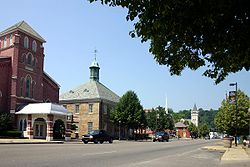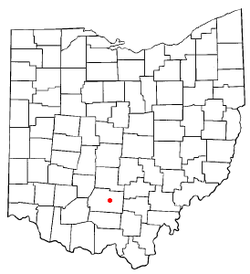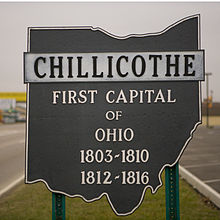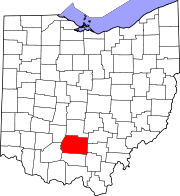- Chillicothe, Ohio
-
City of Chillicothe — City — Overview of Chillicothe from Grandview Cemetery 
SealNickname(s): Ohio's First Capital Location in the state of Ohio Coordinates: 39°20′11″N 82°59′2″W / 39.33639°N 82.98389°WCoordinates: 39°20′11″N 82°59′2″W / 39.33639°N 82.98389°W Country United States State Ohio County Ross Government – Mayor Joseph P. Sulzer (D) Area – Total 9.7 sq mi (25.2 km2) – Land 9.5 sq mi (24.7 km2) – Water 0.2 sq mi (0.5 km2) Elevation 630 ft (190 m) Population (2008) – Total 22,296 – Density 2,284.6/sq mi (882.1/km2) Time zone EST (UTC-5) – Summer (DST) EDT (UTC-4) ZIP code 45601 Area code(s) 740 FIPS code 39-14184[1] GNIS feature ID 1060960[2] Website http://ci.chillicothe.oh.us/ Chillicothe (
 /ˌtʃɪlɨˈkɒθiː/ chil-ə-koth-ee)[3] is a city in and the county seat of Ross County, Ohio, United States.[4]
/ˌtʃɪlɨˈkɒθiː/ chil-ə-koth-ee)[3] is a city in and the county seat of Ross County, Ohio, United States.[4]Chillicothe was the first and third capital of Ohio and is located in southern Ohio along the Scioto River. The name comes from the Shawnee name Chalahgawtha, meaning "principal town", as it was a major settlement of that people. They and their ancestors inhabited the territory for thousands of years prior to European contact. At the time of European-American settlement, the community was plotted by General Nathaniel Massie on his land grant.
The population was 21,797 at the 2000 census. According to the U.S. Census Bureau's annual estimates, Chillicothe had a population of 22,296 in 2008,[5] while the Columbus-Marion-Chillicothe, OH Combined Statistical Area has 2,002,604 people.[6] It is the only city in Ross County and the center of the Chillicothe Micropolitan Statistical Area (as defined by the United States Census Bureau in 2003).
Chillicothe is a designated Tree City USA by the National Arbor Day Foundation.
Contents
History
Modern Chillicothe was the center of the ancient Hopewell tradition, which flourished from 200 BCE until 500 CE. This Amerindian culture had trade routes extending to the Rocky Mountains. They built earthen mounds for ceremonial and burial purposes throughout the Scioto and Ohio River valleys. Later Native Americans who inhabited the area through the time of European contact included Shawnees.
It was after the American Revolution that most European settlement came to this area. Migrants from Virginia and Kentucky moved west along the Ohio River in search of land. Chillicothe served as the capital of Ohio from the beginning of statehood in 1803 until 1810 when Zanesville became the capital for two years.[7] The capital was moved to Zanesville as part of a state legislative compromise to get a bill passed. In 1812 the legislature moved the capital back to Chillicothe. In 1816 the state legislature voted to move the capital again, to Columbus to have it near the geographic center of the state, where it would be more accessible to most citizens.[8]
Migrants to Chillicothe included free blacks, who came to a place with fewer restrictions than in the slave states. They created a vibrant community and aided runaway slaves coming north. As tensions increased prior to the breakout of the American Civil War, the free black community at Chillicothe maintained stations and aid to support refugees on the Underground Railroad. Slaves escaping from the South traveled across the Ohio River to freedom, and then up the Scioto River to get more distance from their former homes and slave hunters. White abolitionists aided the Underground Railroad as well.
Geography
Chillicothe is located at 39°20′11″N 82°59′2″W / 39.33639°N 82.98389°W (39.336525, -82.983822)[9].
According to the United States Census Bureau, the city has a total area of 9.7 square miles (25 km2), of which, 9.5 square miles (25 km2) of it is land and 0.2 square miles (0.52 km2) of it (2.05%) is water.
The city is surrounded by farming communities, and Chillicothe residents describe the area as the foothills of the Appalachians.
Demographics
Historical populations Census Pop. %± 1820 2,426 — 1830 2,846 17.3% 1840 3,977 39.7% 1850 7,100 78.5% 1860 7,626 7.4% 1870 8,920 17.0% 1880 10,938 22.6% 1890 11,288 3.2% 1900 12,976 15.0% 1910 14,508 11.8% 1920 15,831 9.1% 1930 18,340 15.8% 1940 20,129 9.8% 1950 20,133 0% 1960 24,957 24.0% 1970 24,842 −0.5% 1980 23,420 −5.7% 1990 21,923 −6.4% 2000 21,796 −0.6% Est. 2008 22,296 2.3% As of the census[1] of 2000, there were 21,796 people, 9,481 households, and 5,754 families residing in the city. The population density was 2,283.7 people per square mile (882.1/km²). There were 10,303 housing units at an average density of 1,079.5 per square mile (417.0/km²). The racial makeup of the city was 89.21% White, 7.51% African American, 0.34% Native American, 0.56% Asian, 0.04% Pacific Islander, 0.35% from other races, and 2.00% from two or more races. Hispanic or Latino of any race were 0.84% of the population.
There were 9,481 households out of which 25.8% had children under the age of 18 living with them, 43.5% were married couples living together, 13.3% had a female householder with no husband present, and 39.3% were non-families. 34.3% of all households were made up of individuals and 14.8% had someone living alone who was 65 years of age or older. The average household size was 2.24 and the average family size was 2.85.
In the city the population was spread out with 22.2% under the age of 18, 8.4% from 18 to 24, 27.1% from 25 to 44, 24.1% from 45 to 64, and 18.2% who were 65 years of age or older. The median age was 40 years. For every 100 females there were 88.1 males. For every 100 females age 18 and over, there were 83.3 males.
The median income for a household in the city was $33,991, and the median income for a family was $42,477. Males had a median income of $35,199 versus $25,010 for females. The per capita income for the city was $19,101. About 9.3% of families and 12.4% of the population were below the poverty line, including 14.3% of those under age 18 and 9.3% of those age 65 or over.
Government
Public officials
Chillicothe is governed by a mayor-council structure in which the mayor is elected separately from the members of the city council. Chillicothe's mayor is Joseph P. Sulzer (D). The members of the city council are
Ward City Councillor Ward City Councillor First Ward Thomas E. Trutschel (R) At Large Joseph T. Sharp (D) Second Ward Nancy Ames (R) At Large Dustin Proehl (D) Third Ward Queen Lester (D) At Large Napoleon Cross (D) Fourth Ward Jean Malone (D) Council President Bruce A. Arnold (D) Fifth Ward Jeremy M. Siberell (R) Sixth Ward Pat Patrick (R) Other elected officials
Position Officer City Treasurer David A. Neal (D) City Auditor Tom Spetnagel Jr. (D) Public services
Parks and recreation
Chillicothe has several public parks, including Yoctangee Park, Poland Park, Strawser Park, Manor Park, Goldie Gunlock Park, Pine Street Park, Veterans Memorial Park, and Western View Park.
Chillicothe's floodwall, protecting the city from floods of the Scioto River, has a 5.0-mile-long paved bike path. This path connects to the Tri-County Triangle Trail which currently is 17.2 miles long, measured from Bridge St. (SR 159) in Chillicothe, to Frankfort and then to Austin. The Tri-County Triangle Trail's goal is to connect Chillicothe with Washington Court House and Greenfield. This same former railroad continues to Jamestown and Xenia, but those connections are a long range plan.
Hopewell Culture National Historical Park is found on the north end of the city. The park is administered by the National Park Service and has a large concentration of Native American earthworks.
Education
A branch of Ohio University, Ohio University-Chillicothe is a public 4-year institution which enrolls about 2,000 students each year. Daymar College (formerly Southeastern Business College and Samuel Stephen College) offers five different 2-year programs, including Massage Therapy, Business Administration, Criminal Justice, Human Resources Management, and Medical Assisting.
The city of Chillicothe provides education for pre-school through grade 12 students. The Chillicothe City School District includes the following facilities: Allen Elementary; Mt. Logan Elementary, previously Mt. Logan Middle School; Tiffin Elementary; Worthington Elementary; Western Latchkey/Preschool/Western Administration Office, the headquarters of the Board of Education;Chillicothe Middle School; and Chillicothe High School. Additionally, the Academy for Early Learning offers private education. Bishop Flaget Catholic School, the parish school of St. Mary's and St. Peter's Catholic Churches, offers an academic program with the faith-based component to both Catholic and non-Catholic families for students in Prekindergarten through 8th grade.
Chillicothe is also home to the Recording Workshop, an audio engineering school.
Culture
 The south side of West Main Street. The squat, square building left of center is a replica of Ohio's first capitol building and serves as the office of the Chillicothe Gazette.
The south side of West Main Street. The squat, square building left of center is a replica of Ohio's first capitol building and serves as the office of the Chillicothe Gazette.
Majestic Theatre
Chillicothe is home to the 152-year-old continuously operating Majestic Theatre. Its stage has been graced by such greats as Laurel and Hardy, Milton Berle, George Arliss, Sophie Tucker, and many others. In 1853 the Masonic Hall was built, as the first incarnation of what is now the Majestic Theatre. The two-story brick building was a combination lodge room, dance hall, and theatre. Stock companies stayed for as long as a month, performing a repertory of plays. In 1876 the Masons appointed a building committee to enlarge their building. The original building was 40 ft. x 100 ft. and was extended to 50 ft. x 120 ft. Upon completion in December 1876 it was announced that the Masonic Opera House was one of the finest theatres in the state. After the remodeling and with the completion of the Clough Opera House across the city, theatre offerings were tremendous, and varied drama, comedy, farce, minstrel shows and operas were presented.
In 1904 A. R. Wolf bought the Masonic Opera House. Mr. Wolf remodeled the theatre and enlarged the stage. He replaced all the windows in the front of the building with stained glass windows. The Masonic Opera House continued under Wolf's managerial abilities until he sold it to the Myers Brothers in 1915. They again made some improvements and repairs and installed a movie screen and equipment. The Myers Brothers changed the name to the Majestic Theatre. They occasionally had live theatre productions on the stage but finally switched exclusively to motion pictures. In July 1971, Harley and Evelyn Bennett became the new owners of the Majestic Theatre. They did careful restoration with reference to the original wall painting. Three Chillicothe businessmen bought the theatre as a non-profit organization in 1990. All new wiring throughout the theatre, fire safety, and security systems were installed.
Fairs and festivals
Chillicothe, rich in Native American history, hosts the annual Feast of the Flowering Moon Festival. Started in 1984, the May festival draws crowds of approximately 85,000. Yoctangee Park, in the historic downtown, is the setting for this family-oriented, three-day event featuring Native American music, dancing, traders and exhibits, a mountain men encampment, rendezvous with working craftsmen and demonstrations, and an extensive arts and crafts show with more than 80 crafters and commercial exhibits. The main stage has a schedule of family-friendly entertainment, such as local school bands and performers. The streets are lined with food booths and games/contests. Events are free to the public.
On the Friday and Saturday after Labor Day in September, Chillicothe hosts the annual Southern Ohio Storytelling Festival. The festival features concert performances by several highly acclaimed and award-winning storytellers. Storytelling concerts are held throughout the day on both Friday and Saturday. Thousands of students participate during the day on Friday in various venues, including the Majestic Theatre, a tent at the Pump House Art Gallery in Yoctangee Park, and local school auditoriums.
Athletic events
The Chillicothe Paints are a minor league baseball team that was established in February 1993. The team was previously a member of the Frontier League. Now a member of the summer collegiate Prospect League, the Paints played in the independent Frontier League from the 1993 season until the end of the 2008 season. They were one of the original teams in the league. The Paints play their home games at V.A. Memorial Stadium, which opened in 1954.
As the V.A. Memorial Stadium can be turned into a field for many uses, it also plays host to numerous sports events such as the M.A.C. Division baseball playoffs, OHSAA soccer playoffs, and OHSAA baseball playoffs.
In June, the streets of Chillicothe near Yoctangee Park are blocked off to accommodate temporary courts for the Gus Macker three-on-three basketball competition.
Notable natives and residents
Artists and architects
- Martha Finley, author of the Elsie Dinsmore series
- Eston Hemings, violinist and fiddler, son of Sally Hemings and President Thomas Jefferson
- Madison Hemings, Eston's brother, also a fiddler
- Billy Ireland, cartoonist
- Donald Ray Pollock, author
- Noel Sickles, illustrator
- Joe Waters, country music singer
- Nancy Wilson, singer
- Dave Canterbury (survivalist), Co host Dual Survival Show
Athletes
- Neil Johnston, NBA All-Star basketball player
- Ben Hartsock, Carolina Panthers tight end
- Greg Cook, Cincinnati Bengals quarterback
- John Herrnstein, Philadelphia Phillies, University of Michigan football and baseball player
- Scott Bailes, former Major League Baseball player
- Garin Veris, New England Patriots, Stanford University, defensive end
- John Poff, MLB player for the Philadelphia Phillies and Milwaukee Brewers
- Elbie Nickel, Pittsburgh Steelers tight end
- Drew Basil, Ohio State Buckeyes football Student athlete
Ohio founders
- Duncan McArthur, Ohio's 11th Governor
- Edward Tiffin, first Governor of Ohio
- Thomas Worthington, "Father of Ohio Statehood" and Ohio's 6th Governor
Political figures
- Lucy Ware Webb Hayes, First Lady of the United States, wife of President Rutherford B. Hayes
- Lewis Woodson, AME minister, abolitionist, educator, one of the founders of Wilberforce University in 1856
- John Mercer Langston, abolitionist, activist, educator and politician; first black in Ohio elected to public office
- Charles Henry Langston, abolitionist and educator in Ohio and Kansas
- Frederick Madison Roberts, California Assemblyman, believed to be the first African American elected to public office on the West Coast
- David Leroy Nickens, first licensed African-American minister in Ohio
Sister city
- Chillicothe is the sister city of Córdoba, Veracruz, Mexico. This relationship is honored through the Foreign Exchange Student Program with students at Chillicothe High School.
- Chillicothe also is the sister city of Tulua, Valle del Cauca Colombia.
See also
References
 Image of President Woodrow Wilson created by 21,000 standing soldiers at Camp Sherman in Chillicothe, 1918
Image of President Woodrow Wilson created by 21,000 standing soldiers at Camp Sherman in Chillicothe, 1918
- ^ a b "American FactFinder". United States Census Bureau. http://factfinder.census.gov. Retrieved 2008-01-31.
- ^ "US Board on Geographic Names". United States Geological Survey. 2007-10-25. http://geonames.usgs.gov. Retrieved 2008-01-31.
- ^ "A Pronunciation Guide to Places in Ohio". E.W.Scripps School of Journalism. http://scrippsjschool.org/pronunciation/. Retrieved 2008-12-19.
- ^ "Find a County". National Association of Counties. http://www.naco.org/Counties/Pages/FindACounty.aspx. Retrieved 2011-06-07.
- ^ "Annual Estimates of the Population for Incorporated Places in Ohio, Listed Alphabetically: April 1, 2000 to July 1, 2008". U.S. Census Bureau. http://www.census.gov/popest/cities/tables/SUB-EST2008-04-39.csv. Retrieved 2008-08-02.
- ^ "Annual Estimates of the Population of Combined Statistical Areas: April 1, 2000 to July 1, 2008". U.S. Census Bureau. http://www.census.gov/popest/metro/tables/2008/CBSA-EST2008-02.csv. Retrieved 2008-08-02.
- ^ tfd. "Zanesville definition of Zanesville in the Free Online Encyclopedia". http://encyclopedia2.tfd.com/Zanesville. Retrieved 2007-11-24.
- ^ tfd. "Chillicothe definition of Chillicothe in the Free Online Encyclopedia". http://encyclopedia2.tfd.com/Chillicothe. Retrieved 2007-11-24.
- ^ "US Gazetteer files: 2010, 2000, and 1990". United States Census Bureau. 2011-02-12. http://www.census.gov/geo/www/gazetteer/gazette.html. Retrieved 2011-04-23.
External links
- "Capitals of Ohio", Ohio Historical Society
- Pat Medert, "Chillicothe History", Chillicothe, OH Website
- Chillicothe Gazette (newspaper) Information Source of Record for Chillicothe
- Downtown information
- Chillicothe & Ross County Public Library
- Chillicothe.com Community site with active message boards
- Ross County Visitor's Bureau
- Chillicothe News, Events, Weather and Citizen Journalism
- Chillicothe Police Chillicothe Police Department
Municipalities and communities of Ross County, Ohio City Chillicothe
Villages Adelphi | Bainbridge | Clarksburg | Frankfort | Greenfield‡ | Kingston | South Salem
Townships CDP Unincorporated
communitiesGhost town Footnotes ‡This populated place also has portions in an adjacent county or counties
Categories:- Chillicothe, Ohio
- Cities in Ohio
- County seats in Ohio
- Former United States state capitals
- Populated places in Ross County, Ohio
- Populated places established in 1803
Wikimedia Foundation. 2010.







